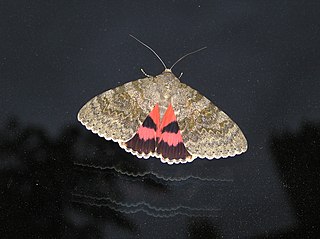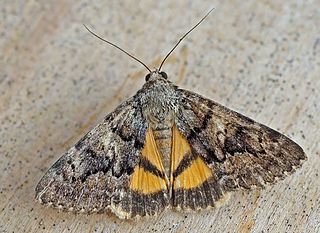
The red underwing is a moth of the family Erebidae. The species was first described by Carl Linnaeus in his 1767 12th edition of Systema Naturae.

Catocala is a generally Holarctic genus of moths in the family Erebidae. The genus was erected by Franz von Paula Schrank in 1802. The moths are commonly known as underwing moths or simply underwings. These terms are sometimes used for a few related moths, but usually – especially when used in plural, not as part of a species name – they are used to refer to Catocala only.

Catocala elocata, the French red underwing, is a moth of the family Erebidae. It is found in Central Europe, Southern Europe, North Africa, Anatolia, Uzbekistan, and Kazakhstan.

Catocala fulminea, the yellow bands underwing, is a moth of the family Erebidae. The species was first described by Giovanni Antonio Scopoli in his 1763 Entomologia Carniolica. It is found in central and southern Europe, east Asia and Siberia. The xarippe lineage has been proposed to be a distinct and valid species in its own right, instead of being only subspecifically distinct.

Catocala nymphaea is a species of moth of the family Erebidae. It was described by Eugenius Johann Christoph Esper in 1787. It is found in southern France, Austria, Albania, Portugal, Croatia, Italy, Greece, Corsica, Sicily, Crete, North Africa, Anatolia, Afghanistan and Kashmir.

Catocala ultronia, the dark red underwing or ultronia underwing, is a moth of the family Erebidae. The species was first described by Jacob Hübner in 1823. It is found in most of eastern North America, south to Florida and Texas. It ranges west across the southern parts of Canada to extreme southeast British Columbia.

Catocala puerpera is a moth of the family Erebidae first described by Michel-Esprit Giorna in 1791. It is found in Mediterranean and sub-Mediterranean areas of the Near East and Middle East and in North Africa.

Catocala conversa is a moth of the family Erebidae first described by Eugenius Johann Christoph Esper in 1787. It is found in the Mediterranean zone and parts of the sub-Mediterranean zone.

Catocala armandi is a moth of the family Erebidae. It is found in south-east Asia, including Tibet and Taiwan.

Catocala columbina is a moth of the family Erebidae. It is found in Sichuan, Zhejiang, Taiwan and Japan.

Ulotrichopus macula is a moth of the family Erebidae. It is found in the Indian Subregion, Taiwan, Thailand, Sundaland, Sulawesi and Seram.

Catocala wushensis is a moth of the family Erebidae. It is found in Taiwan.
Catocala tokui is a moth of the family Erebidae. It is found in Japan and Taiwan.

Catocala dejeani is a moth of the family Erebidae first described by Rudolf Mell in 1936. It is found in China and Taiwan.

Asota heliconia is a moth in the family Erebidae. It is found from the Indo-Australian tropics east to Queensland and the Solomons.

Catocala pataloides is a moth of the family Erebidae first described by Rudolf Mell in 1931. It is found in northeastern Laos and in the southeastern Chinese provinces of Guangxi, Guangdong and Hunan. and Taiwan.

Catocala formosana is a moth in the family Erebidae first described by Okano in 1958. It is found in Taiwan.

Catocala naganoi is a moth in the family Erebidae first described by Shigero Sugi in 1982. It is found exclusively in Taiwan.

Catocala nivea is a moth in the family Erebidae first described by Arthur Gardiner Butler in 1877. It is found in Japan and Taiwan.
Catocala praegnax is a moth in the family Erebidae first described by Francis Walker in 1858. It is found in Japan, northern China and Taiwan.















